From the towering heights of the Supersaurus in North America to the marvelous Argentinosaurus, this article brings to life the awe-inspiring scale and diversity of sauropods. Let’s marvel at these ancient behemoths that once ruled the earth, which were not only the largest dinosaurs but also probably the largest land animals ever.
1. Supersaurus: “Super Lizard”
| Attribute | Detail |
|---|---|
| Family | Diplodocidae |
| Found in | Morrison Formation, Colorado |
| Diet | Herbivorous |
| Lived | 153-145 mya |
| Length | 42 m |
| Height | 17 m |
| Weight estimate | 40,000 kg |
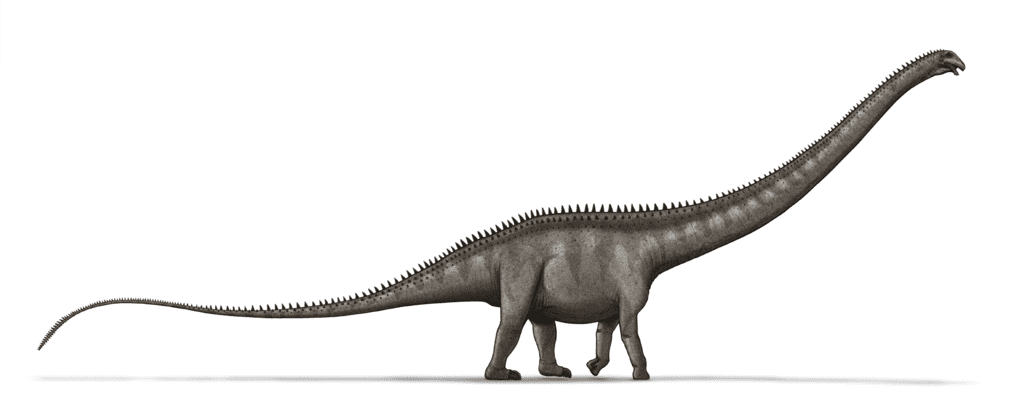
Supersaurus, aptly named for its size, was a sauropod that inhabited North America, around 153 to 145 million years ago. The “super lizard” is one of the largest known dinosaurs. Estimates suggest that Supersaurus could have stretched up to 42 meters in length and weighed as much as 40 tons.
“Jimbo”, a specimen discovered in Wyoming, in 1986, had a 30% complete skeleton, piecing together the puzzle of Supersaurus‘ holotype. As a herbivore, Supersaurus used its long neck for high browsing, feeding on vegetation that other dinosaurs could not access.
2. Maraapunisaurus: “Huge Lizard”
| Attribute | Detail |
|---|---|
| Family | Rebbachisauridae |
| Found in | Garden Park, Colorado |
| Diet | Herbivorous |
| Lived | ~150 mya |
| Length | 58 m |
| Height | 7.5 m |
| Weight estimate | 150,000 kg |
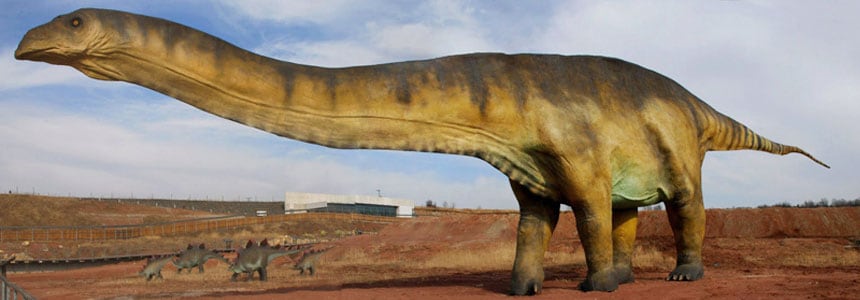
Maraapunisaurus fragillimus is a giant that was once shrouded in mystery. Initially known as Amphicoelias, based on a single vertebra, it’s a contender for the title of the longest dinosaur. Edward Drinker Cope first described the vertebra in the 19th century, suggesting an immense sauropod. However, initial size estimates varied due to the incomplete fossil record. The name “fragillimus” hints at the fragility of the only bone piece identified. The fossil has since been lost to time, turning the dinosaur into a legend of the paleontological world.
Despite the disappearance of the physical evidence, the recorded dimensions have fueled ongoing debates about the true size of Maraapunisaurus. Some speculate it could reach lengths up to 58 m and a weight of around 150 tons. This sauropod’s classification has fluctuated, with some recent discussions suggesting it might belong to the Rebbachisauridae family.
3. Argentinosaurus: “Argentina Lizard”
| Family | Titanosauria |
| Found in | Neuquén, Argentina |
| Diet | Herbivorous |
| Lived | 96-92 mya |
| Length | 35 m |
| Height | 14 m |
| Weight estimate | 50,000-100,000 kg |

Argentinosaurus huinculensis reached up to 35 meters in length and weighed around 100,000 kg. This giant roamed present-day Argentina 96 million years ago, hence the dinosaur’s name “Argentina Lizard”.
This sauropod’s massive size is inferred from fragmentary remains, including vertebrae, ribs, and limb bones, found encased in hard rock. The story of its discovery began in 1987 when Guillermo Heredia stumbled upon what he initially thought were petrified logs. This find, later excavated by José F. Bonaparte and his team, introduced Argentinosaurus to science, giving us our first description of the creature. Argentinosaurus is a titanosaur, a subgroup of dinosaurs known for their long necks and tails. The extensive neck facilitated reaching high vegetation to sustain its enormous body on a diet of high-canopy tough plants. Due to its immense size, paleontologists speculate it took 15 years for Argentinosaurus hatchlings to reach adulthood. It’s probably only during this period in this animal’s life cycle that Argentinosaurus was vulnerable against predators like Giganotosaurus.
4. Patagotitan: “Patagonian Titan”
| Attribute | Detail |
|---|---|
| Family | Titanosauria |
| Found in | La Flecha, Argentina |
| Diet | Herbivorous |
| Lived | ~100 mya |
| Length | 38 m |
| Height | ~13 m |
| Weight estimate | 77,000 kg |
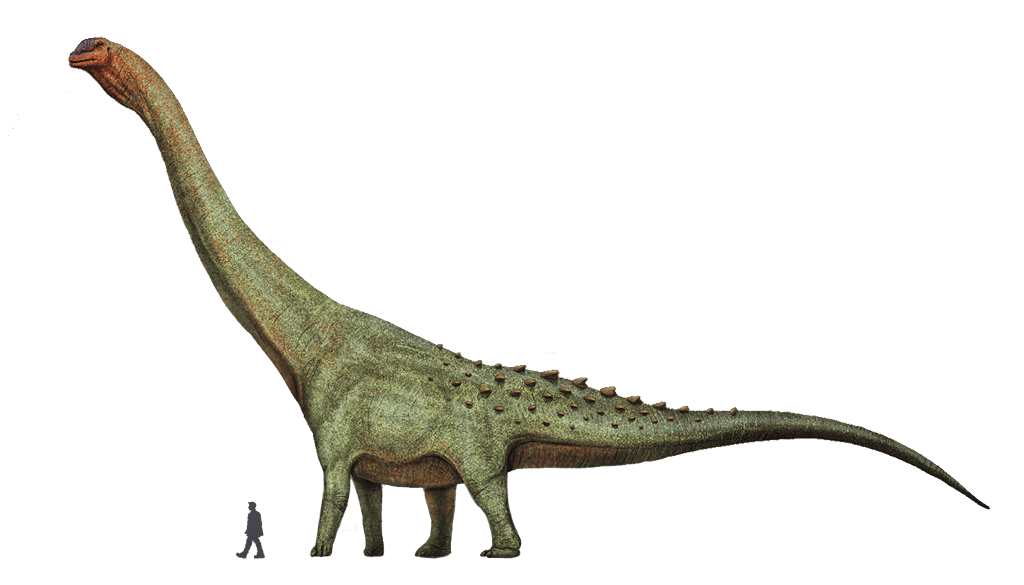
The next titanosaur on our list is Patagotitan, the “Patagonian Titan”. This Argentinian giant could reach an incredible 38 meters in length, towered 13 meters in height, and weighed around 77,000 kg. It was first discovered on La Flecha Ranch after a ranch worker noticed a large fossil protruding from the ground. This led to the excavation of hundreds of bones belonging to at least six individuals of the species. These individuals seemed to be buried across three distinct flood events. Such a wealth of material makes Patagotitan one of the most completely known titanosaurs.
Patagotitan was a quadrupedal herbivore, characterized by its long neck and tail, which it used to browse for food. Its teeth were designed for stripping vegetation, allowing it to consume a diet comprised mostly of tough plant material. Living in the Early Cretaceous period, about 100 million years ago, Patagotitan’s environment was heavily forested. Like modern elephants, these sauropods would have had to consume vast amounts of vegetation, possibly eating for up to 20 hours a day to sustain their massive bodies.
5. Dreadnoughtus: “Fears Nothing”
| Attribute | Detail |
|---|---|
| Family | Titanosauria |
| Found in | Cerro Fortaleza Formation, Argentina |
| Diet | Herbivorous |
| Lived | 84-66 mya |
| Length | ~26 m |
| Height | 9 m |
| Weight estimate | 48,000 kg |
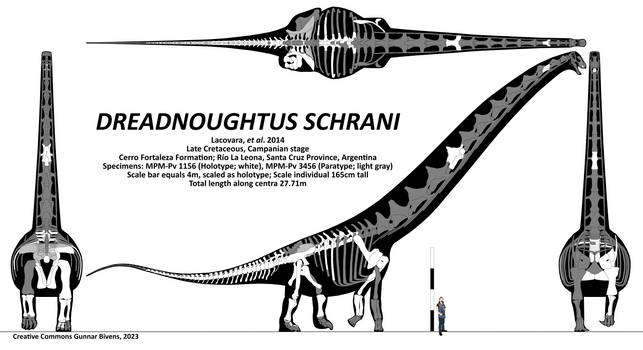
Dreadnoughtus represents the most complete titanosaur skeleton paleontologists have ever found. It had an estimated length of 26 meters and a weight of around 48 metric tons. The animal was discovered in Argentina and has provided significant insights into the life of titanosaurs that were often represented by fragmentary fossils. Named for its seemingly invincible size, akin to the dreadnought battleships, the term “Dreadnoughtus” implies “fears nothing” reflecting its position on top of the food chain. The preservation of more than half of its skeleton has allowed scientists to conduct detailed studies of Dreadnoughtus’ anatomy. The largest known specimen had apparently not yet reached its full size, indicating that it could have grown even larger.
Dreadnoughtus lived in Patagonia, Argentina, during a period characterized by warm climates and rich biodiversity. Its massive size would have required a continuous intake of vegetation. The animal’s long neck would have helped it reach from high canopies as well as ground-level plants.
6. Futalognkosaurus: “Giant Chief Lizard”
| Attribute | Detail |
|---|---|
| Family | Titanosauria |
| Found in | Neuquén, Argentina |
| Diet | Herbivorous |
| Lived | 94-86 mya |
| Length | 26-30 m |
| Height | ~10 m |
| Weight estimate | 33,000 |
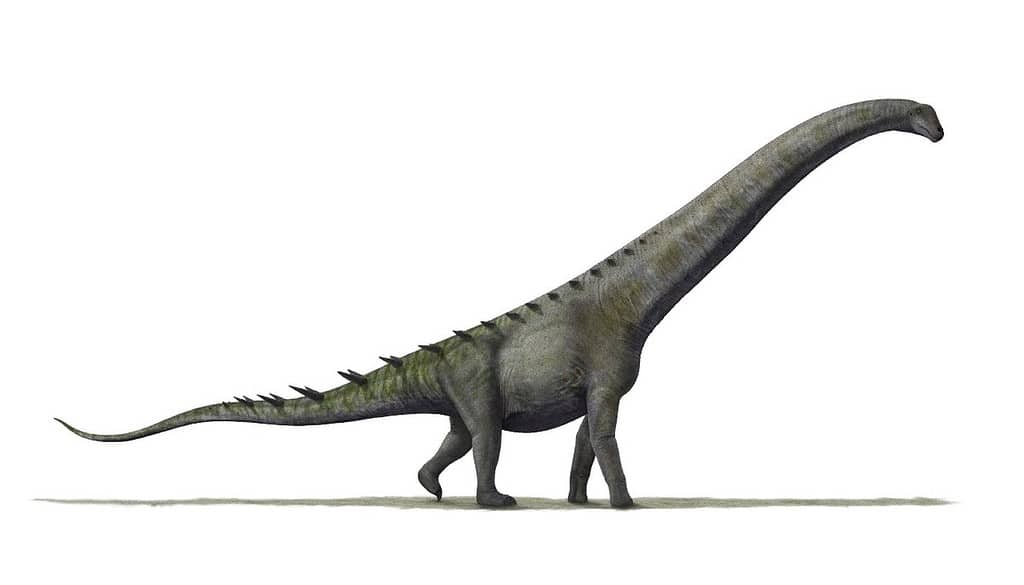
Futalognkosaurus (allow me to help: FOO-tə-long-ko-SAW-rəs) translates to “Giant Chief Lizard” in the Mapuche language. Discovered in Neuquén, Argentina, in 2000, it wasn’t formally described until 2007 by paleontologist Jorge Calvo and his team. This Late Cretaceous giant lived between 94 and 86 million years ago and was among the largest dinosaurs ever discovered. Initial length estimates range between 32 to 34 meters. However, more recent assessments suggest a length closer to 26 meters and a weight of 33 tons.
Futalognkosaurus‘ was discovered alongside other fauna, including Megaraptor and Unenlagia in the same site. The titanosaur’s long neck was possibly over a meter thick due to tall neural spines. Just like his long-necked dinosaur cousins before him, Futalognkosaurus was a herbivore, feeding on the abundant vegetation of its time.
7. Turiasaurus: “Turia Lizard”
| Attribute | Detail |
|---|---|
| Family | Turiasauria |
| Found in | Kimmeridgian Villar del Arzobispo Formation, Spain |
| Diet | Herbivorous |
| Lived | ~145 mya |
| Length | 30-35 m |
| Height | 12 m |
| Weight estimate | 48,000 kg |

Turiasaurus, the “Turia lizard,” is a remarkable sauropod discovered in the Kimmeridgian Villar del Arzobispo Formation of Teruel, Spain. This dinosaur, known from a single fossil specimen, stands out due to its immense size, making it the largest dinosaur ever found in Europe. Estimates of its length have varied over time, with early guesses suggesting it could be over 35 meters long. This significant size places it as a prominent figure among the sauropods of its time.
Turiasaurus lived during the Jurassic-Cretaceous transition. Its habitat was supposedly a coastal floodplain with a mix of muddy and sandy regions. Turiasaurus‘ diet was herbivorous, similar to other sauropods, requiring it to consume vast quantities of vegetation to sustain its massive body. Scientists think that this dinosaur formed herds for protection, as its size alone would not have made it completely immune to predators.
8. Giraffatitan: “Giraffe Titan”
| Attribute | Detail |
|---|---|
| Family | Brachiosauridae |
| Found in | Tendaguru Formation, Tanzania |
| Diet | Herbivorous |
| Lived | 154-142 mya |
| Length | 23 m |
| Height | 13 m |
| Weight estimate | ~ 35,000 kg |
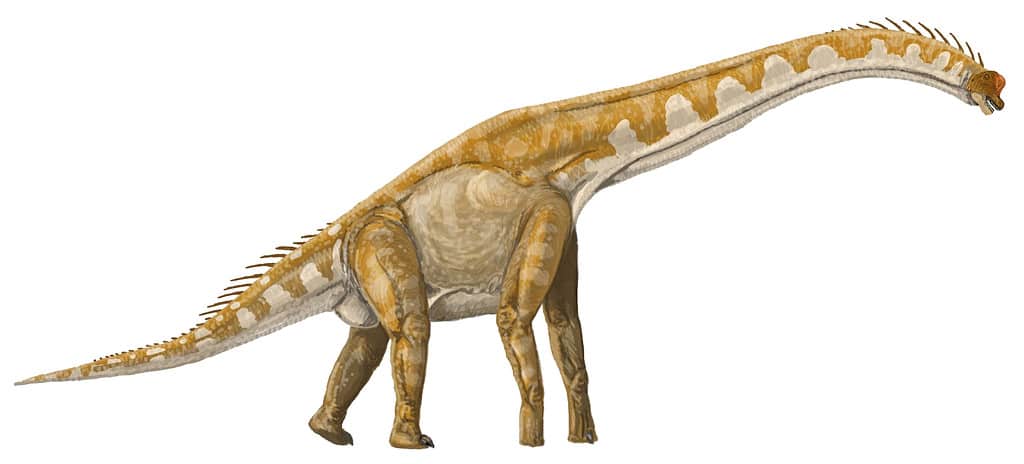
Giraffatitan, once considered a species of Brachiosaurus, is a distinct genus of sauropod dinosaur that lived during the Late Jurassic period, approximately 154-142 million years ago. This massive herbivore came to light in the Tendaguru Formation in Tanzania, Africa. It’s known for its long neck and tail, with an estimated length of 23 meters, earning the nickname “giraffe titan.”
The discovery of Giraffatitan began in the early 20th century, led by German paleontologist Werner Janensch. The Tendaguru expeditions of 1909 unearthed numerous Giraffatitan fossils alongside other dinosaur species. Based on these findings, Giraffatitan was then crowned as the largest land animal that ever lived until the discovery of the titanosaurs that dethroned it.
Giraffatitan’s diet consisted of high-reaching vegetation, which it could access thanks to its elongated neck. This neck had up to 19 vertebrae and measured a staggering 11 meters in length. For comparison, the humble giraffe’s neck is slightly longer than two meters. The Jurassic dinosaur’s locomotion was on all four legs, supported by broad, flat soles and large, clawless toes adapted to bear its immense weight.
9. Brachiosaurus: “Arm Lizard”
| Attribute | Detail |
|---|---|
| Family | Brachiosauridae |
| Found in | Colorado River Valley, Colorado |
| Diet | Herbivorous |
| Lived | 150–130 mya |
| Length | 26 m |
| Height | 13 m |
| Weight estimate | 36,000 kg |

Brachiosaurus altithorax, a sauropod, roamed North America during the Late Jurassic period, approximately 150 million years ago. The name Brachiosaurus translates to “arm lizard,” a nod to its unusually long arms, and “altithorax” means “deep chest.” Brachiosaurus is estimated to have reached lengths of 26 meters and weighed about 35 tons. Its distinctive body structure, characterized by longer forelimbs than hindlimbs, resulted in a steeply inclined trunk, a feature that set it apart from other sauropods.
This dinosaur is known from the Morrison Formation and is considered one of the rarer sauropods from this geological formation. It was a high browser, likely using its long neck to feed on top canopy vegetation. Brachiosaurus was also initially once considered to be the largest dinosaur, contributing to its iconic appearance in popular culture, notably in the 1993 film “Jurassic Park”.
10. Sauroposeidon: “Lizard Earthquake God”
| Attribute | Detail |
|---|---|
| Family | Titanosauria |
| Found in | rural Oklahoma |
| Diet | Herbivorous |
| Lived | 89-110 mya |
| Length | 27-34 m |
| Height | 18.5 m |
| Weight estimate | ~60,000 kg |
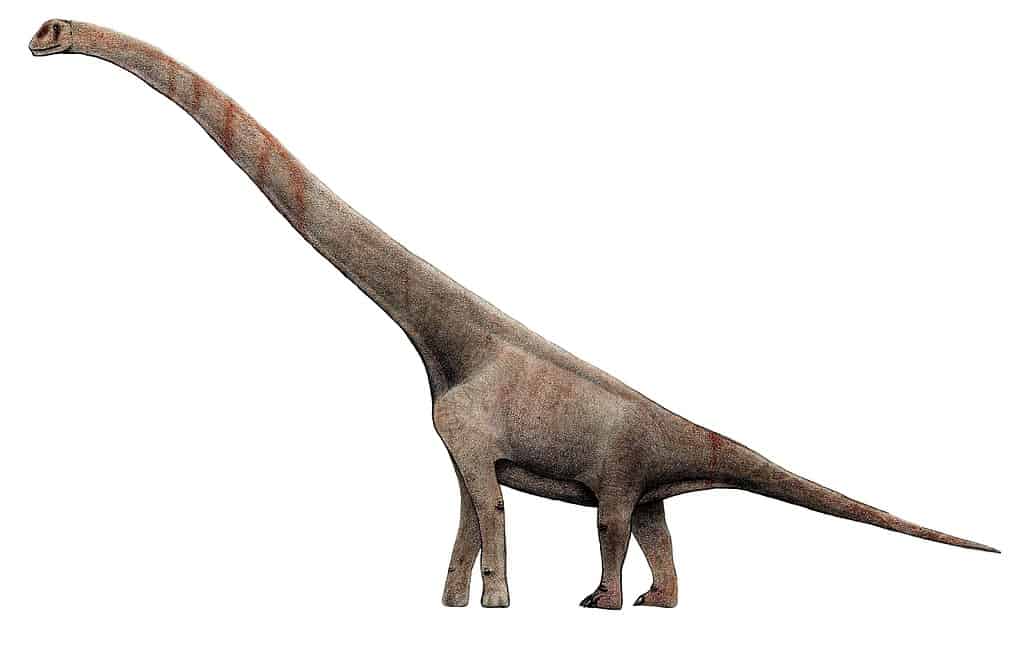
Sauroposeidon, a name that evokes the grandeur of the “earthquake god Poseidon,” may very well be the tallest dinosaur ever described. Discovered in the late 20th century in North America, this dinosaur is estimated to have reached up to 18.5 meters tall. Living during the Early Cretaceous, Sauroposeidon’s massive size suggests it lived a largely unchallenged life, with very few predators being capable of posing a threat. The Cretaceous dinosaur’s long neck, supported by a relatively lightweight, air-filled bone structure, would have allowed it to graze on high canopy vegetation, covering vast areas in search of food without the need for constant relocation. Thus, fossil evidence suggests that Sauroposeidon was a highly successful species, thriving in the lush, forested environments of prehistoric North America.






